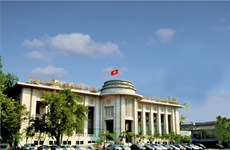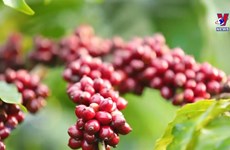Fisheries sector records rapid but unstable growth
Vietnam’s fisheries sector has grown
at about 18 percent per annum during the 1998-2008 period - one of the
fastest rates for the sector in the world - yet worries remain that the
growth is not sustainable.
Vietnam’s fisheries sector has grown
at about 18 percent per annum during the 1998-2008 period - one of the
fastest rates for the sector in the world - yet worries remain that the
growth is not sustainable.
At a seminar on the impact of the World Trade Organisation entry on the fisheries sector held on August 20, the Ministry of Agriculture and Rural Development (MARD) said that Vietnam since 2001 has been listed among the top ten aquatic product exporters in the world, and, in 2008, the country jumped to sixth place in export turnover, third in aquaculture output and 13th in seafood catch.
Within two years of the WTO integration, the sector has achieved high growth rates, with 4.2 million tonnes in output and 3.8 billion USD in export turnover recorded in 2007, and 4.6 million tonnes and 4.6 billion USD in 2008.
The Vietnam Association of Seafood Exporters and Producers (VASEP) said Vietnam’s aquatic products now are sold to more than 160 countries and territories worldwide with the quality continuously improving.
So far, over 300 enterprises meet EU standards for imported products, and more than 400 export to the US , China , the Republic of Korea and other markets.
For the domestic economy, the fisheries sector plays an important role, contributing some 7.3 percent of the country’s total export value in 2008, providing jobs to more than 4 million labourers, and bringing direct or indirect income to some 10 percent of the population. During the past 15 years, the sector has contributed over 5 percent to the country’s GDP.
On the domestic market, aquatic products are among the traditional foods favoured by Vietnamese, particularly the fresh ones. Each Vietnamese annually consumes an average of up to 36 kg, and the figure is continuing to increase.
However, it is the sector’s high growth in both production and export value that provokes concern over the sustainability of this development.
“The development of the fisheries sector in the recent times is too quick and unstable in all economic, environmental and social aspects,” said VASEP Vice President Nguyen Huu Dung.
Besides threats to the environment or the exhaustion of aquatic resources, Vietnamese aquatic producers have not yet built up trademarks for their products, and have to sell under the labels of importers or foreign distribution networks.
Moreover, according to VASEP, the promotion of Vietnamese aquatic products on the world market is hindered by an irrational production price structure, in which material costs account for 70 percent of total costs, where as transport, transaction fees and marketing put together only make up 1 percent.
Officials from the MARD’s Department for International Cooperation worry that the implementation of a series of WTO commitments from now to Oct. 1, 2010, including product origin labels and the management of fishing boats, is an “impossible” task for the sector.
Thus, the seminar was held with the aim of collecting suggestions from experts and authorities from the localities with fishery-driven economies in order to complete and issue a national plan of action to sustainably develop the sector in the 2010-2012 period./.
At a seminar on the impact of the World Trade Organisation entry on the fisheries sector held on August 20, the Ministry of Agriculture and Rural Development (MARD) said that Vietnam since 2001 has been listed among the top ten aquatic product exporters in the world, and, in 2008, the country jumped to sixth place in export turnover, third in aquaculture output and 13th in seafood catch.
Within two years of the WTO integration, the sector has achieved high growth rates, with 4.2 million tonnes in output and 3.8 billion USD in export turnover recorded in 2007, and 4.6 million tonnes and 4.6 billion USD in 2008.
The Vietnam Association of Seafood Exporters and Producers (VASEP) said Vietnam’s aquatic products now are sold to more than 160 countries and territories worldwide with the quality continuously improving.
So far, over 300 enterprises meet EU standards for imported products, and more than 400 export to the US , China , the Republic of Korea and other markets.
For the domestic economy, the fisheries sector plays an important role, contributing some 7.3 percent of the country’s total export value in 2008, providing jobs to more than 4 million labourers, and bringing direct or indirect income to some 10 percent of the population. During the past 15 years, the sector has contributed over 5 percent to the country’s GDP.
On the domestic market, aquatic products are among the traditional foods favoured by Vietnamese, particularly the fresh ones. Each Vietnamese annually consumes an average of up to 36 kg, and the figure is continuing to increase.
However, it is the sector’s high growth in both production and export value that provokes concern over the sustainability of this development.
“The development of the fisheries sector in the recent times is too quick and unstable in all economic, environmental and social aspects,” said VASEP Vice President Nguyen Huu Dung.
Besides threats to the environment or the exhaustion of aquatic resources, Vietnamese aquatic producers have not yet built up trademarks for their products, and have to sell under the labels of importers or foreign distribution networks.
Moreover, according to VASEP, the promotion of Vietnamese aquatic products on the world market is hindered by an irrational production price structure, in which material costs account for 70 percent of total costs, where as transport, transaction fees and marketing put together only make up 1 percent.
Officials from the MARD’s Department for International Cooperation worry that the implementation of a series of WTO commitments from now to Oct. 1, 2010, including product origin labels and the management of fishing boats, is an “impossible” task for the sector.
Thus, the seminar was held with the aim of collecting suggestions from experts and authorities from the localities with fishery-driven economies in order to complete and issue a national plan of action to sustainably develop the sector in the 2010-2012 period./.













